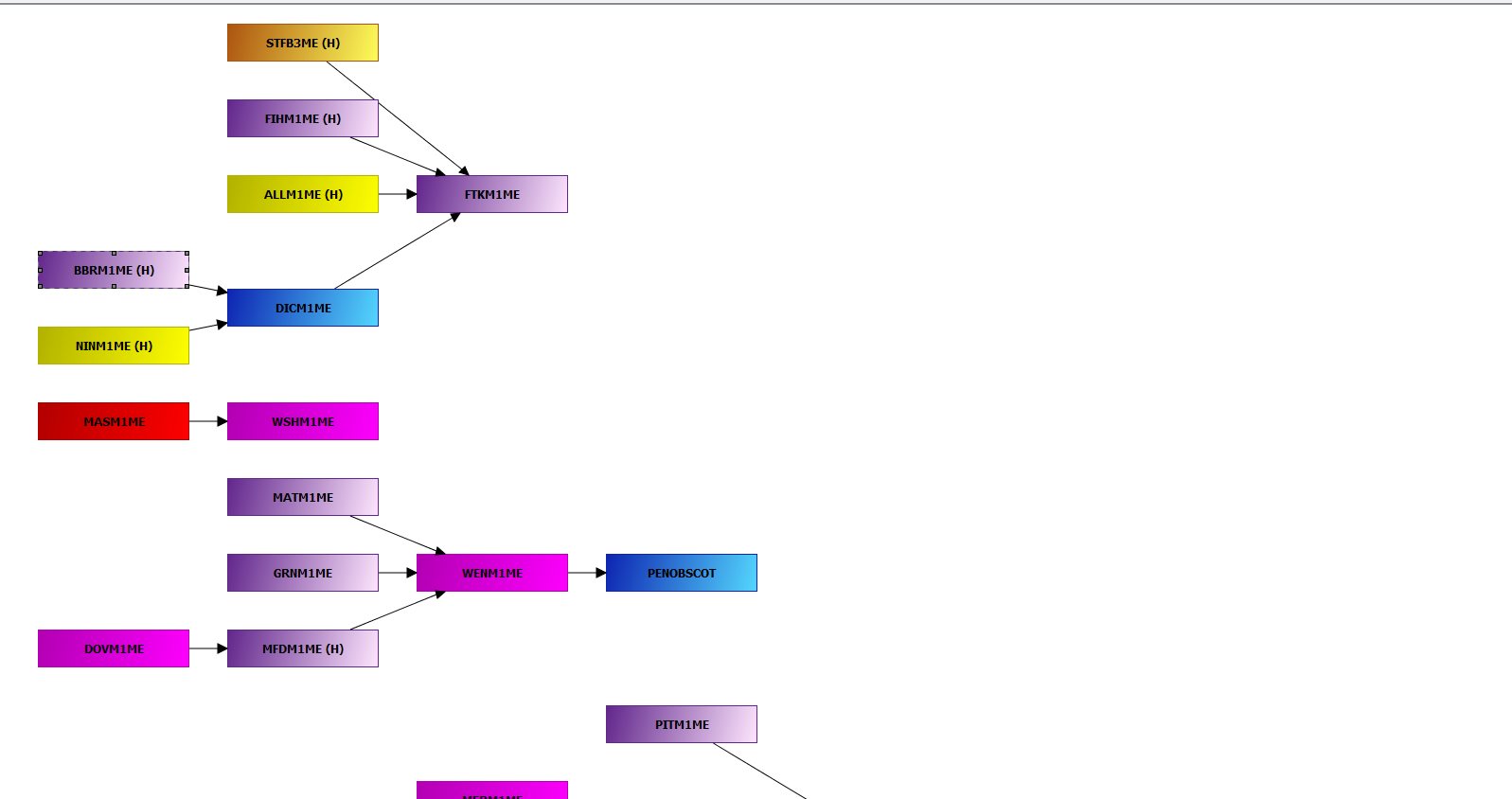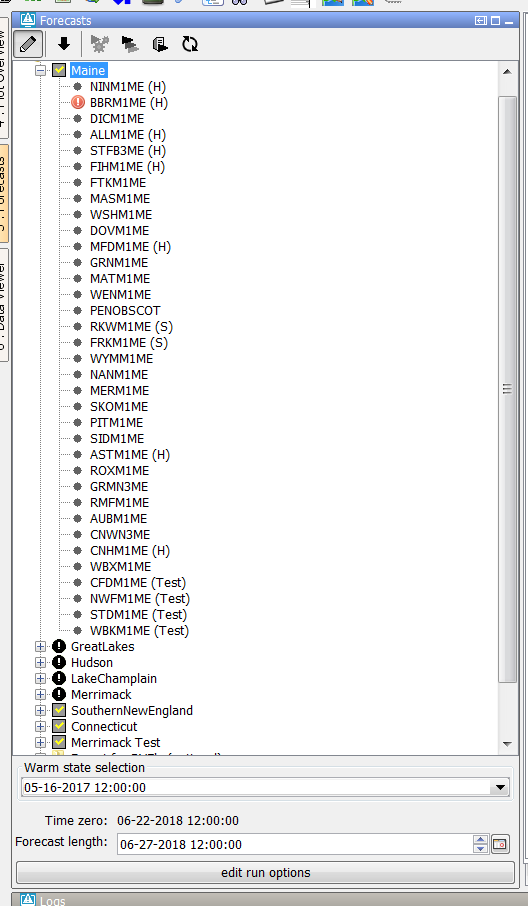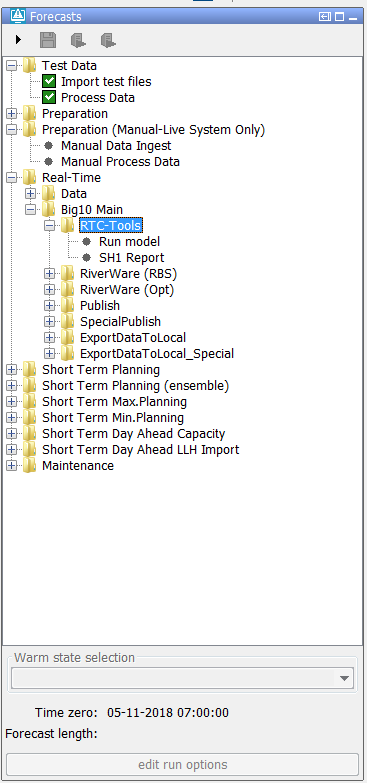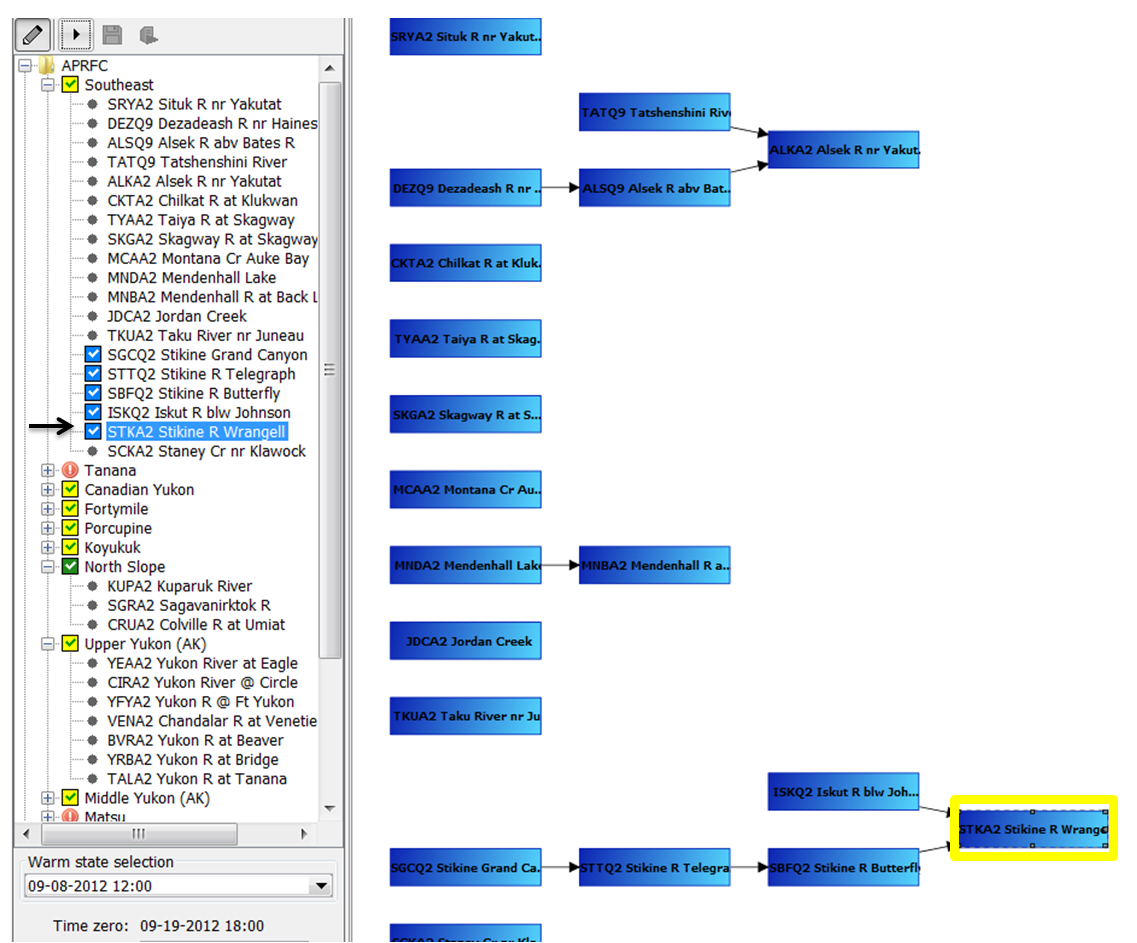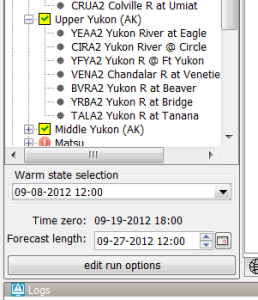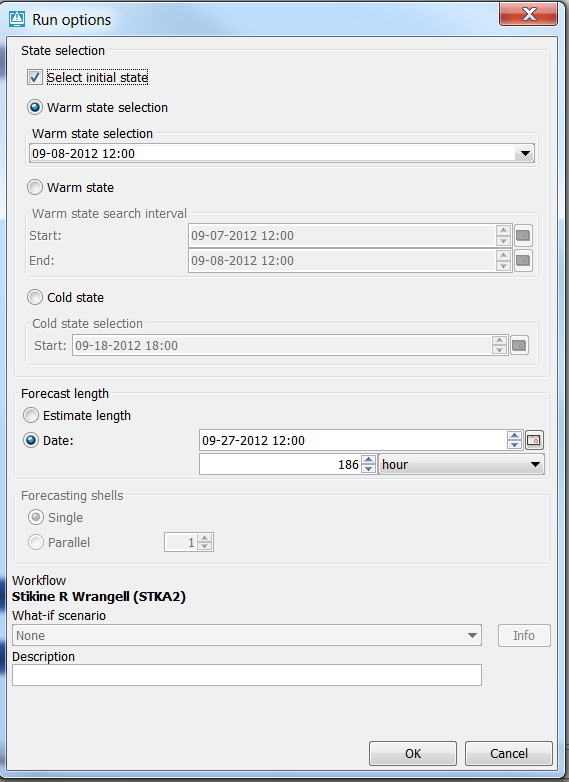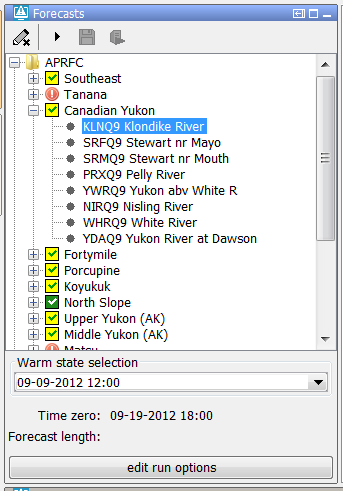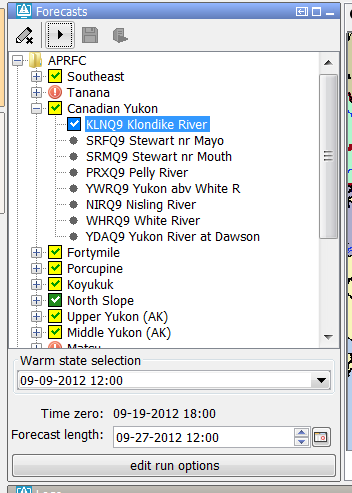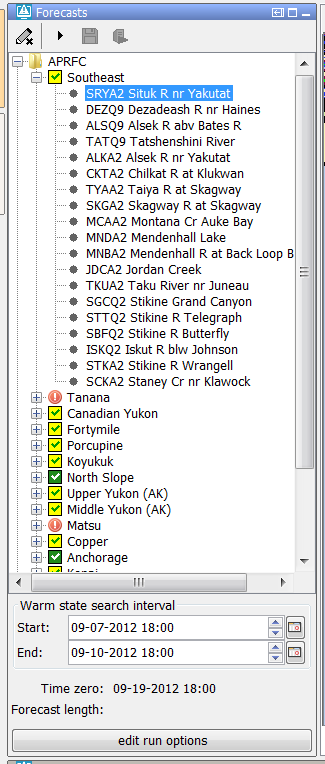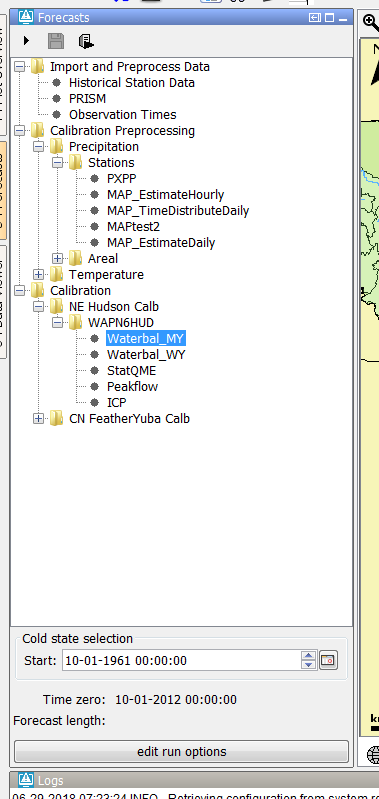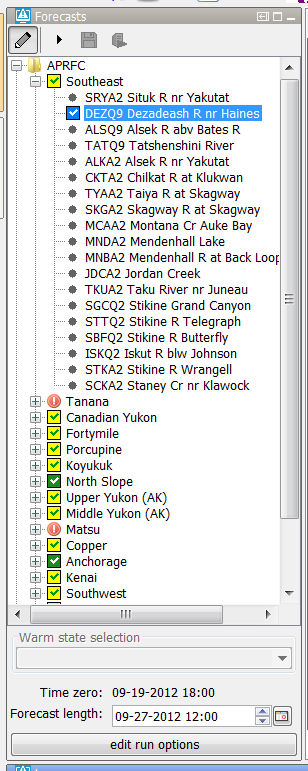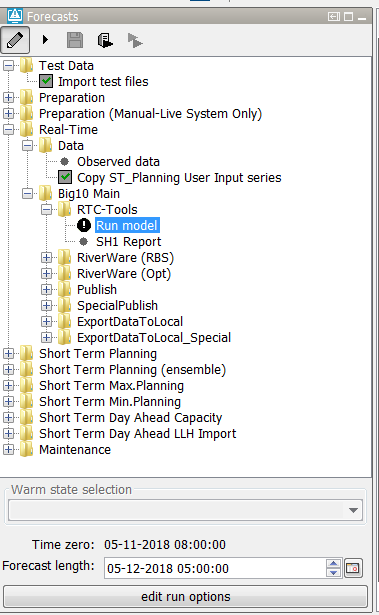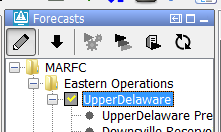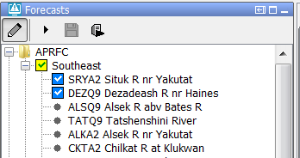| scrollbar | ||
|---|---|---|
| Excerpt | ||
| ||
Functionality to define qualifiers to time series, next to locationIds and parameterIds |
Function: | Configure topology of an IFD environment |
Where to Use? | Mandatory for an IFD installation |
Why to Use? | The topology.xml is necessary to be able to use panels like the topology panel and the forecast panel |
Description: | Topology panel is used to define the topology of an IFD environment. Also the behaviour of the forecast panel which is used to start |
Available since: | Delft-FEWS 2010.01 |
Contents
| Table of Contents | ||||
|---|---|---|---|---|
|
Introduction
The concept of the IFD (interactive forecast displays) was introduced in 2010. A central role in the configuration of the IFD is the topology.xml. This part of the wiki explains the configuration details of the topology.xml. First The Overview sections explains the background of the topology.xml wil be explained in the overview section. In the following sections . The rest of this page explains the configuration options will be explained in detail.
Overview
The topology.xml is a mandatory configuration file when you are setting up an IFD-environment. This configuration file is used was originally designed to configure the topology of a Delft-FEWS -system. The topology system, which is defined by individual nodes and their connectivity. The topology can be viewed in the topology panel, which shows a block diagram of the topology. An example is shown below.
, or in the forecast panel, which shows a tree view of the topology (see screenshots below).
The behaviour of the forecast panel can also be configured in the topology-fileMost Delft-FEWS systems nowadays use the topology.xml to configure the work process of the forecaster in the IFD-environment. The topology.xml is a mandatory configuration file when you are setting up an IFD-environment (Interactive Forecasting Display). The topology.xml is used to configure the behavior of the forecast panel. This will be explained in more detail in the next sections.
The topology.xml plays a central role in configuring an IFD-environment since it is used to configure the forecast panel which is the central panel in an IFD-environment.
The topology.xml was originally designed to configure the topology of a Delft-FEWS system but there are a lot of Delft-FEWS systems in which the topology.xml is used to configure the work process of the forecaster instead.
An example is given below.
Running workflows from the topology tree
The topology tree can be configured in the following way. The example below shows a simple topology tree with two leaf nodes A and B.
Both of them belong the group node C.
TopologyGroup.xml
It is possible to split the configuration of the topology in separate configuration files.
The main configuration file is always the topology.xml. The other (supporting) configuration files are the topology group files. The topology group files should be placed in the RegionConfigfiles folder. The name of a topology group file should start with TopologyGroup.
An example of a topology group file is shown below.
| Code Block | ||
|---|---|---|
| ||
<? | ||
| Code Block | ||
| ||
<?xml version="1.0" encoding="UTFutf-8"?> <topology<topologyGroup xmlns="http://www.wldelft.nl/fews" xmlns:xsi="http://www.w3.org/2001/XMLSchema-instance" xsi:schemaLocation="http://www.wldelft.nl/fews httphttps://fewsfewsdocs.wldelftdeltares.nl/schemas/version1.0/topologytopologyGroup.xsd"> <nodes<group id="C" name="C"ForecastGroup_Bear"> <node<nodes id="ABear" name="A"/> Bear"> <workflowId>Bear_Forecast</workflowId> <node id="BMergeMAPBear" name="BMergeMAP and Outflow"/> </nodes> </topology> |
It is possible to run workflows from the topology panel. In the example below some of the node(s) have a workflow configured.
<workflowId>Bear_Forecast</workflowId>
<moduleInstanceId>SetTimes_Forecast</moduleInstanceId>
<moduleInstanceId>MergeMAP_Bear_Forecast</moduleInstanceId>
<moduleInstanceId>Merge_RiverWare_Observed_QT</moduleInstanceId>
<visibleModifierGroup>None</visibleModifierGroup>
</node>
</nodes>
</group>
</topologyGroup>
|
The defined topology groups can be used in the topology.xml by using the element <groupId>. An example is shown below.
| Code Block | ||
|---|---|---|
| ||
<?xml<nodes versionid="1.0InflowForecast" encodingname="UTF-8"?Inflow Forecast"> <warmState unit="day" multiplier="11"/> <groupId>ForecastGroup_Bear</groupId> |
Running workflows from the topology tree
The topology tree can be configured in the following way. The example below shows a simple topology tree with two leaf nodes A and B.
Both of them belong the group node C.
| Code Block | ||
|---|---|---|
| ||
<?xml version="1.0" encoding="UTF-8"?> <topology xmlns="http://www.wldelft.nl/fews" xmlns:xsi="http://www.w3.org/2001/XMLSchema-instance" xsi:schemaLocation="http://www.wldelft.nl/fews https://fewsdocs.deltares.nl/schemas/version1.0/topology.xsd"> <nodes id="C" <topology xmlns="http://www.wldelft.nl/fews" xmlns:xsi="http://www.w3.org/2001/XMLSchema-instance" xsi:schemaLocation="http://www.wldelft.nl/fews http://fews.wldelft.nl/schemas/version1.0/topology.xsd"> <nodes id="C" name="C"> <workflowId>workflowC</workflowId> <node id="A" name="A"/> <workflowId>workflowA</workflowId> </node> <node id="B" name="B"/> </nodes> </topology> |
Please note, if the same workflow node is selected more than once, and a description is specified, then a notification dialog pops up after the OK button is clicked. If the user chooses to change the description, then the edit run options dialog comes back, and the description text would be selected (which indicates the description text is ready to be edited).
IFD runs
By default all the workflows started from a leaf node are started in IFD mode. The results of an IFD-run are only temporary available in FEWS (until the next restart) and are only available and visible at the operator client which started the run.
IFD runs are typically used to evaluate the effect of modifiers on the results of a forecast.
Server run
A workflow which is started from a group node will by default be started as a server run. A server run will run at a FSS when it is started from an operator client. When it is started from a stand alone it will run locally but the results of the run will be available after a restart of the system.
It is possible to change these default settings by using the element localRun.
In the example below the runs from leaf node B will run in server mode and the runs started from the group node C will run in IFD mode.
It is possible to run workflows from the topology panel. In the example below some of the node(s) have a workflow configured.
| Code Block | ||
|---|---|---|
| ||
<?xml version="1.0" encoding="UTF-8"?>
<topology xmlns="http://www.wldelft.nl/fews" xmlns:xsi="http://www.w3.org/2001/XMLSchema-instance" xsi:schemaLocation="http://www.wldelft.nl/fews https://fewsdocs.deltares.nl/schemas/version1.0/topology.xsd">
<nodes id="C" name="C">
<workflowId>workflowC</workflowId>
<node id="A" name="A">
<workflowId>workflowA</workflowId>
</node> | ||
| Code Block | ||
| ||
<?xml version="1.0" encoding="UTF-8"?> <topology xmlns="http://www.wldelft.nl/fews" xmlns:xsi="http://www.w3.org/2001/XMLSchema-instance" xsi:schemaLocation="http://www.wldelft.nl/fews http://fews.wldelft.nl/schemas/version1.0/topology.xsd"> <nodes id="C" name="C"> <workflowId>workflowC</workflowId> <localRun>true</localRun> <node id="AB" name="AB"/> <workflowId>workflowA<</workflowId> <localRun>false</localRun> </node> <node id="B" name="B"/> </nodes>nfo </nodes> </topology> |
It is possible to connect nodes in the topology. In the example below the node STKA2 is connected to two previous nodes (SBFQ2 and ISKQ2).
| Code Block | ||
|---|---|---|
| ||
<node id="STKA2" name="STKA2 Stikine R Wrangell">
<previousNodeId>SBFQ2</previousNodeId>
<previousNodeId>ISKQ2</previousNodeId>
<workflowId>STKA2_Forecast</workflowId>
</node> |
The way nodes are connected plays an important role when running workflows in IFD mode.
The example below shows the situation before the forecaster starts an IFD run for the node STKA2. The topology tree shows that this node has not run yet (icon is a black dot) and that it is connected to two previous nodes SBFQ2 and ISKQ2.
When the forecaster starts an IFD run for node STKA2 Delft-FEWS will detect that node STKA2 is connected to two other nodes which have to run before the run for STKA2 can be started.
One of these nodes (SBFQ2) also has a previous node which has to run prior to running this node. Before running node STKA2 the IFD system will make sure that first all the necessary previous nodes are run in the correct order before node STKA2 will be run. The example below shows the forecast tree after the run for STKA2 was finished. It shows that not only an IFD run was started for STKA2 but also for all its previous nodes.
By default the workflow on a leaf node is started automatically after selecting the node. This can be disabled by setting the option <enableAutoRun> to false.
The option will apply to all nodes.
For IFD runs the connected previous nodes are always started before the IFD run for the selected node can be run.
For server runs the connected previous nodes are by default not taken into account. If the option <enableRunUpstreamServerNodes> is set to true the previous nodes will also be started prior to running the workflow of the selected node.
The option <checkStatusPreviousServerRun> can be used to force that a server run can only be started if the status of all of its previous nodes is fully successful.
Previous nodes which are connected to a node but belong to a different group in the topology tree are ignored by default when starting previous nodes for a selected node. By setting the option <enableCrossGroupNodeReferencing> to true previous nodes in a different group will also be taken into account.
Secondary workflow
It is possible to define a secondary workflow for a node. This secondary workflow can be run by clicking the button in the button bar.
Only the primary workflow determines which icon is shown in the forecast tree.
Below is an example of a node with a secondary workflow.
| Code Block | ||
|---|---|---|
| ||
<node id="Copy_User_Input_series_ST_Planning_to_RT" name="Copy ST_Planning User Input series">
<workflowId>Copy_User_Input_series_ST_Planning_to_RT</workflowId>
<secondaryWorkflowId>Copy_User_Input_series_ST_Planning_to_RT</secondaryWorkflowId>
<runSecondaryWorkflowAtServer>false</runSecondaryWorkflowAtServer>
<timeSeriesButtonsPanelId>Observed</timeSeriesButtonsPanelId>
<graceTime unit="hour" multiplier="1"/>
<localRun>true</localRun>
<saveLocalRunEnabled>true</saveLocalRunEnabled>
<showRunApprovedForecastButton>true</showRunApprovedForecastButton>
</node> |
runSecondaryWorkflowWithTaskRunPropertiesFromIFD
The secondary workflow runs by default with the settings in the xml-file. Since the 2019.02 release however it is also possible to run the secondary workflow with the settings from the IFD.
To enable this the tag runSecondaryWorkflowWithTaskRunPropertiesFromIFD must be set to true.
Run options panel
It is possible to manually select the task properties which will be used in the runs started from the IFD. This can be done in the panel below the forecast tree. The picture belows shows an example of this panel.
The options which are shown in this panel are configurable. Each node or group of nodes in the topology can have different options.
More advanced options are available in the run options panel. This panel is started when the forecaster clicks on the edit run options button.
The "edit run options" button can be disabled by setting the option <disableAdvancedButton> to true. The "edit run options" button can be disabled for a single node or a group node and its children.
In the section below several typical configuration examples are given which will be explained in detail.
Warm state selection
In a lot of systems, for example NWS systems, only the state selection is configured. The time zero will in this case be equal to the system time.
The forecast length will be determined by the forecast length estimator.
| Code Block | ||
|---|---|---|
| ||
<nodes id="APRFC">
<showModifiers>true</showModifiers>
<workflowId>APRFC_Forecast</workflowId>
<warmState unit="day" multiplier="10"/>
<!-- Topology added for forecast group Southeast -->
<nodes id="Southeast" name="Southeast">
<workflowId>Southeast_Forecast</workflowId> |
Below a screenshot of the system prior to running a node. The state selection is set to -10 days. The forecast length is not set and the time zero is equal to the system time.
After the run the forecast length which was determined by the forecast length estimator in the run is shown in the panel.
The forecaster can adjust the forecast length by using the time chooser.
It is possible to disable the possiblity to edit the forecast length by using the option <useForecastLengthFromInteractiveForecastDisplay>.
An configuration example is shown below.
| Code Block | ||
|---|---|---|
| ||
<node id="SRYA2" name="SRYA2 Situk R nr Yakutat">
<workflowId>SRYA2_Forecast</workflowId>
<useForecastLengthFromInteractiveForecastDisplay>false</useForecastLengthFromInteractiveForecastDisplay>
</node> |
When the system time changes the selected state will also change so the relative time compared to time zero will stay the same.
Warm state selection period
The option warm state selection period can be used to set the state selection to a period (relative to the system time) in which the system will search for a warm state.
An example of a node which is configured with a warm state search period is given below.
A configuration example is given below.
| Code Block | ||
|---|---|---|
| ||
<nodes id="Southeast" name="Southeast">
<workflowId>Southeast_Forecast</workflowId>
<warmStateSelectionPeriod unit="day" start="-12" end="-9"/>
<node id="SRYA2" name="SRYA2 Situk R nr Yakutat">
<workflowId>SRYA2_Forecast</workflowId>
<useForecastLengthFromInteractiveForecastDisplay>false</useForecastLengthFromInteractiveForecastDisplay>
</node> |
Cold state selection
It is also possible to set the default state selection for a node or a group of nodes to a cold state selection. This is used, for example, in FEWS system which are used for calibration purposes.
An configuration example is given below.
| Code Block | ||
|---|---|---|
| ||
<nodes id="WAPN6HUD_calb" name="WAPN6HUD">
<workflowId>WAPN6HUD_Stats_Calibration</workflowId>
<coldState unit="day" multiplier="18628"/>
<node id="WAPN6HUD_Waterbalance_Multi-year" name="Waterbal_MY"> |
Alternatively, in FEWS release 2019.02 and higher a fixed cold state start date/time can be configured:
| Code Block | ||
|---|---|---|
| ||
<nodes id="WAPN6HUD_calb" name="WAPN6HUD">
<workflowId>WAPN6HUD_Stats_Calibration</workflowId>
<coldStateStartTime date="2019-01-01" />
<node id="WAPN6HUD_Waterbalance_Multi-year" name="Waterbal_MY"> |
No initial state
The option <noInitialState> can be used to disable the state selection for a node so that the state will be selected by the workflow.
An example of a node which has this option enabled is shown below.
A configuration example is given below.
| Code Block | ||
|---|---|---|
| ||
<nodes id="Southeast" name="Southeast">
<workflowId>Southeast_Forecast</workflowId>
<noInitialState></noInitialState> |
Relative period panel
When the forecaster wants to run a workflow for a certain period of time then the relative period panel is a good option to use. The picture belows shows an example of the relative period panel.
This option is used, for example, in the HERMES-system. Below a configuration example:
| Code Block | ||
|---|---|---|
| ||
<node id="ProcessTest" name="Process Data">
<workflowId>ProcessImports</workflowId>
<relativePeriod unit="day" start="-30" end="0"/>
<localRun>false</localRun>
</node> |
When the system time is changed then the start time and end time will also change so that the relative period will stay the same for a topology node.
It is possible to force the initial start time and end time to match a certain time step. This can be done by using the options <initialStartTimeCardinalTimeStep> and <initialEndTimeCardinalTimeStep>.
To force user edits to the start and/or end time to a certain time step the options <cardinalTimeStepStartTime> and <cardinalTimeStepEndTime> can be used.
If the option <initialStartTimeCardinalTimeStep> is used then the start time will not change when the system time changes. The same applies for the end time and the option <initialEndTimeCardinalTimeStep>.
localRun
Workflows started from a leaf node are by default started in IFD mode (i.e. local run). The results of an IFD-run are only temporary available in FEWS (until the next restart) and are only available and visible at the operator client which started the run. IFD runs are typically used to evaluate the effect of modifiers on the results of a forecast.
Workflows started from a group node (nodes) are by default started as a server run. A server run will run at a FSS when it is started from an operator client. When it is started from a stand alone it will run locally but the results of the run will be available after a restart of the system.
You can change these default settings with the element <localRun>. In the example below the runs from leaf nodes A (localRun=false) and B (defaults to false) will run in server mode and the runs started from the group node C will run in IFD mode (localRun=true).
| Code Block | ||
|---|---|---|
| ||
<?xml version="1.0" encoding="UTF-8"?>
<topology xmlns="http://www.wldelft.nl/fews" xmlns:xsi="http://www.w3.org/2001/XMLSchema-instance" xsi:schemaLocation="http://www.wldelft.nl/fews https://fewsdocs.deltares.nl/schemas/version1.0/topology.xsd">
<nodes id="C" name="C">
<workflowId>workflowC</workflowId>
<localRun>true</localRun>
<node id="A" name="A">
<workflowId>workflowA</workflowId>
<localRun>false</localRun>
</node>
<node id="B" name="B"/>
</nodes>nfo
</topology>
|
previousNodeId
It is possible to connect nodes in the topology. In the example below the node STKA2 is connected to two previous nodes (SBFQ2 and ISKQ2). The way nodes are connected plays an important role when running workflows in IFD mode.
| Code Block | ||
|---|---|---|
| ||
<node id="STKA2" name="STKA2 Stikine R Wrangell">
<previousNodeId>SBFQ2</previousNodeId>
<previousNodeId>ISKQ2</previousNodeId>
<workflowId>STKA2_Forecast</workflowId>
</node> |
Example previousNodeId
The example below shows the situation before the forecaster starts an IFD run for the node STKA2. The topology tree shows that this node has not run yet (icon is a black dot) and that it is connected to two previous nodes SBFQ2 and ISKQ2.
When the forecaster starts an IFD run for node STKA2 (see arrow) Delft-FEWS will detect that node STKA2 is connected to two other nodes which have to run before the run for STKA2 can be started. One of these nodes (SBFQ2) also has a previous node which has to run prior to running this node. Before running node STKA2 the IFD system will make sure that first all the necessary previous nodes are run in the correct order before node STKA2 will be run.
The screenshot on the right shows the forecast tree after the run for STKA2 was finished. It shows that not only an IFD run was started for STKA2 but also for all its previous nodes.
enableAutoRun
By default the workflow on a leaf node is started automatically after selecting the node. This can be disabled by setting the option <enableAutoRun> to false. The option will apply to all nodes.
enableRunUpstreamServerNodes
For IFD (local) runs the connected previous nodes are always started before the IFD run for the selected node can be run.
For server runs the connected previous nodes are by default not taken into account. If the option <enableRunUpstreamServerNodes> is set to true the previous nodes will also be started prior to running the workflow of the selected node.
checkStatusPreviousServerRun
The option <checkStatusPreviousServerRun> can be used to force that a server run can only be started if the status of all of its previous nodes is fully successful.
enableCrossGroupNodeReferencing
Previous nodes which are connected to a node but belong to a different group in the topology tree are ignored by default when starting previous nodes for a selected node. By setting the option <enableCrossGroupNodeReferencing> to true previous nodes in a different group will also be taken into account.
Note, if the same workflow node is selected more than once, and a description is specified, then a notification dialog pops up after the OK button is clicked. If the user chooses to change the description, then the edit run options dialog comes back, and the description text would be selected (which indicates the description text is ready to be edited).
Secondary workflow
It is possible to define a secondary workflow for a node. This secondary workflow can be run by clicking the button in the button bar.
Only the primary workflow determines which icon is shown in the forecast tree.
Below is an example of a node with a secondary workflow.
| Code Block | ||
|---|---|---|
| ||
<node id="Copy_User_Input_series_ST_Planning_to_RT" name="Copy ST_Planning User Input series">
<workflowId>Copy_User_Input_series_ST_Planning_to_RT</workflowId>
<secondaryWorkflowId>Copy_User_Input_series_ST_Planning_to_RT</secondaryWorkflowId>
<runSecondaryWorkflowAtServer>false</runSecondaryWorkflowAtServer>
<timeSeriesButtonsPanelId>Observed</timeSeriesButtonsPanelId>
<graceTime unit="hour" multiplier="1"/>
<localRun>true</localRun>
<saveLocalRunEnabled>true</saveLocalRunEnabled>
<showRunApprovedForecastButton>true</showRunApprovedForecastButton>
</node> |
runSecondaryWorkflowWithTaskRunPropertiesFromIFD
The secondary workflow runs by default with the settings in the xml-file. Since the 2019.02 release however it is also possible to run the secondary workflow with the settings from the IFD.
To enable this the tag runSecondaryWorkflowWithTaskRunPropertiesFromIFD must be set to true.
popupMessageServerRun
With this option it is possible to define a message which will be shown when a server run is started from this node.
Run options panel
It is possible to manually select the task properties which will be used in the runs started from the IFD. This can be done in the panel below the forecast tree. The picture belows shows an example of this panel.
The options which are shown in this panel are configurable. Each node or group of nodes in the topology can have different options.
More advanced options are available in the run options panel. This panel is started when the forecaster clicks on the edit run options button.
The "edit run options" button can be disabled by setting the option <disableAdvancedButton> to true. The "edit run options" button can be disabled for a single node or a group node and its children.
In the section below several typical configuration examples are given which will be explained in detail.
Warm state selection
In a lot of systems, for example NWS systems, only the state selection is configured. The time zero will in this case be equal to the system time.
The forecast length will be determined by the forecast length estimator.
| Code Block | ||
|---|---|---|
| ||
<nodes id="APRFC">
<showModifiers>true</showModifiers>
<workflowId>APRFC_Forecast</workflowId>
<warmState unit="day" multiplier="10"/>
<!-- Topology added for forecast group Southeast -->
<nodes id="Southeast" name="Southeast">
<workflowId>Southeast_Forecast</workflowId> |
Below a screenshot of the system prior to running a node. The state selection is set to -10 days. The forecast length is not set and the time zero is equal to the system time.
After the run the forecast length which was determined by the forecast length estimator in the run is shown in the panel.
The forecaster can adjust the forecast length by using the time chooser.
It is possible to disable the possiblity to edit the forecast length by using the option <useForecastLengthFromInteractiveForecastDisplay>.
An A configuration example is shown below.
| Code Block | ||
|---|---|---|
| ||
<node id="ProcessSRYA2" name="Process DataSRYA2 Situk R nr Yakutat"> <previousNodeId>Import</previousNodeId> <workflowId>ProcessImports</workflowId> <relativePeriod unit="day" start="-10" end="-5"/> <cardinalTimeStepStartTime unit="hour" multiplier="6"/> <initialStartTimeCardinalTimeStep unit="hour"/> <cardinalTimeStepEndTime unit="hour" multiplier="6"/> <initialEndTimeCardinalTimeStep unit="hour"/> <localRun>false</localRun> </node> |
Relative period panel with only a start time
It is possible to a create a relative period panel in which the end time is hidden.
Below an example of such a panel.
<workflowId>SRYA2_Forecast</workflowId>
<useForecastLengthFromInteractiveForecastDisplay>false</useForecastLengthFromInteractiveForecastDisplay>
</node> |
When the system time changes the selected state will also change so the relative time compared to time zero will stay the same.
Warm state selection period
The option warm state selection period can be used to set the state selection to a period (relative to the system time) in which the system will search for a warm state.
An example of a node which is configured with a warm state search period is given below.
A configuration example is given belowThis panel can be configured in the following way.
| Code Block | ||
|---|---|---|
| ||
<node<nodes id="ProcessTestSoutheast" name="Process DataSoutheast"> <workflowId>ProcessImports< <workflowId>Southeast_Forecast</workflowId> <relativeStartTime <warmStateSelectionPeriod unit="day" start="-12" valueend="-109"/> <node id="SRYA2" name="SRYA2 Situk R <localRun>false</localRun> nr Yakutat"> <workflowId>SRYA2_Forecast</workflowId> <useForecastLengthFromInteractiveForecastDisplay>false</useForecastLengthFromInteractiveForecastDisplay> </node> |
Cold state
...
selection
It is also possible to
...
To set the default state selection at for a node or a group of nodes to the a cold state selection which was used in another run the option <coldStateFromCurrentRun> can be used..
An configuration example is given below.Below a configuration example
| Code Block | ||
|---|---|---|
| ||
<node <nodes id="rainfallpolicyWAPN6HUD_tweedcalb" name="Set Rainfall PolicyWAPN6HUD"> <workflowId>Tweed_Rainfall_Forecast</workflowId> <coldStateFromCurrentRun> <workflowId>Tweed<workflowId>WAPN6HUD_URBSStats_IFD_Forecast<Calibration</workflowId> <coldState unit="day" multiplier="218628"/> </coldStateFromCurrentRun> <defaultModifierId>Rainfall Policy</defaultModifierId> <visibleModifierGroup>URBS_Official_Rainfall</visibleModifierGroup> <localRun>true</localRun> <showRunApprovedForecastButton>false</showRunApprovedForecastButton> </node> |
In the example above the cold state which was used in the current run from workflow "Tweed URBS IFD forecast" will be used.
It is possible to define a default state selection for the cases that a current run is not available yet. In the example above this default is set to a cold state selection of 2 days before time zero.
If time zero changes the cold state selection should also change to keep the relative period the same.
Forecast length
To set the forecast length at a fixed length the option <forecastLength> can be used.
It is possible to force the end time of the forecast (time zero plus forecast length) to match a certain time step by using the option <initialForecastLengthCardinalTimeStep>.
The end time of a node is only forced to match this time step when the user selects the node for the first time.
To force the end time of a node to match a certain time step when the forecaster tries the edit the default forecast length the option <cardinalTimeStepForecastLength> can be used.
By default the end time of a node changes when the system time changes so that the forecast length stays the same.
However if for a node the option <initialForecastLengthCardinalTimeStep> is configured then the end time of the node stays the same if the time zero changes.
A configuration example of a node for which a forecast length, an <initialForecastLengthCardinalTimeStep> and a <cardinalTimeStepForecastLength> is configured is shown below.
| Code Block | ||
|---|---|---|
| ||
<node id="B10_Main_RTC" name="Run model">
<workflowId>Big10_RTCTools_RT</workflowId>
<forecastLength unit="hour" multiplier="24"/>
<cardinalTimeStepForecastLength unit="hour"/>
<initialForecastLengthCardinalTimeStep unit="hour" multiplier="6"/>
<displayGroupId>Main_RT-RTC</displayGroupId>
<timeSeriesButtonsPanelId>RT_buttons_Main</timeSeriesButtonsPanelId>
<viewPermission>execute</viewPermission>
<visibleModifierGroup>RT</visibleModifierGroup>
<graceTime unit="hour" multiplier="1"/>
<localRun>true</localRun>
<saveLocalRunEnabled>true</saveLocalRunEnabled>
<showRunApprovedForecastButton>true</showRunApprovedForecastButton>
</node> |
Below a screenshot of this node after it is selected for the first time is shown.
The end time of the run (forecast length) was first set to time zero plus 24 hours. Because this time wasn't a valid time for the configured
<initialForecastLengthCardinalTimeStep> the end time was set to first valid time prior to the end time.
Below a screenshot of the same node after the sytem time was changed. The time zero is changed but the end time of the node is still fixed at the same time.
Time zero
By default the time zero of a node is equal to the system time and not editable.
It is possible to make the time zero editable and to set it to a fixed date/time.
The code snippet below shows a configuration example.
| Code Block | ||
|---|---|---|
| ||
<node id="ZWF_LHM_Z0_REF2017BP18" name="Files LHM zonder zout">
<workflowId>ZWF_LHM_Z0_REF2017BP18</workflowId>
<timeZero date="2004-01-01" time="00:00:00"/>
<localRun>false</localRun>
</node> |
To make the time zero editable and/or to shfit the time zero compared to the system time the option <timeZeroShift> can be used.
| Code Block | ||
|---|---|---|
| ||
<nodes id="WaterOrder HADT1" name="Water Order Apalachia">
<timeZeroShift unit="hour" multiplier="0"/>
<node id="WaterOrder_HADT1" name="Adjust Water Order">
<locationId>HADT1</locationId>
<workflowId>CalculateSpill_WaterOrder_HADT1</workflowId> |
If the shift is set to 0 then the time zero will be editable but equal to the system time.
Custom info label
It is possible to define a custom info label which be shown (if configured) below the run options.
It is possible to use location attribute in the custom info label. if a value is modified it will be colored blue.
Below a configuration example.
| Code Block | ||
|---|---|---|
| ||
<node id="Big10_RUN_Riverware_ST_Planning" name="Riverware (RBS) test">
<workflowId>Big10_RiverWare_ST_Planning</workflowId>
<displayGroupId>ST_P_Big10_SUM_Riverware</displayGroupId>
<timeSeriesButtonsPanelId>ST_BASIN_buttons</timeSeriesButtonsPanelId>
<customInfoLabel>
<labelText>This is an example! first attribute: @wMarketChoice_RT@ second attribute: @SPILL_PRIORITY_RT@</labelText>
<locationId>BPA</locationId>
<overrulingUnmodifiedDateTimeAttributeValue>
<attributeId>wMarketChoice_RT</attributeId>
<offset unit="day" multiplier="1"/>
<timeStep unit="day"/>
</overrulingUnmodifiedDateTimeAttributeValue>
</customInfoLabel>
<graceTime unit="hour" multiplier="5"/>
<localRun>true</localRun>
<saveLocalRunEnabled>true</saveLocalRunEnabled>
<showRunApprovedForecastButton>true</showRunApprovedForecastButton>
</node> |
It a date/time attribute is not modified the default value will be shown. It is also possible to configure an overruling value if the date/time attribute is unmodfied.
This can be done by using the overrulingUnmodifiedDateTimeAttributeValue. The value can be configured by defining an offset and a time step.
The overruling value will be determined by adding the configured offset to the time zero of the node and setting the determined time to the first valid time of the defined time step.
Custom colors
You can configure the text and background color(selected and non-selected). These are optional fields, you can configure all, none, or some. These properties can be configured on individual nodes and group nodes. Feature available since 2019.02.
Example:
| Code Block | ||||
|---|---|---|---|---|
| ||||
<?xml version="1.0" encoding="UTF-8"?>
<!-- edited with XMLSpy v2009 sp1 (http://www.altova.com) by ICT (Stichting Deltares) -->
<topology xmlns="http://www.wldelft.nl/fews" xmlns:xsi="http://www.w3.org/2001/XMLSchema-instance"
xsi:schemaLocation="http://www.wldelft.nl/fews http://fews.wldelft.nl/schemas/version1.0/topology.xsd">
<enableAutoRun>false</enableAutoRun>
<nodes id="Tasks">
<node id="Import" name="Import">
<workflowId>Import</workflowId>
<backgroundSelectionColor>forest green</backgroundSelectionColor>
<backgroundNonSelectionColor>pale green4</backgroundNonSelectionColor>
</node>
<node id="Transformation" name="Transformation">
<workflowId>Transformation</workflowId>
<textSelectionColor>gray18</textSelectionColor>
<textNonSelectionColor>dark salmon</textNonSelectionColor>
</node>
<node id="CanadaMeteo" name="CanadaMeteo">
<workflowId>CanadaMeteo</workflowId>
<backgroundSelectionColor>light yellow3</backgroundSelectionColor>
<backgroundNonSelectionColor>turquoise3</backgroundNonSelectionColor>
<textSelectionColor>yellow</textSelectionColor>
<textNonSelectionColor>red</textNonSelectionColor>
</node>
<node id="NoosImport" name="NoosImport">
<workflowId>NoosImport</workflowId>
<textSelectionColor>yellow</textSelectionColor>
<backgroundNonSelectionColor>light pink2</backgroundNonSelectionColor>
</node>
<node id="RotterdamPort" name="RotterdamPort">
<workflowId>RotterdamPort</workflowId>
<textNonSelectionColor>peach puff</textNonSelectionColor>
</node>
<node id="KiwisImport" name="KiwisImport">
<workflowId>KiwisImport</workflowId>
</node>
<node id="TaoGrid" name="TaoGrid">
<workflowId>TaoGrid</workflowId>
<backgroundNonSelectionColor>cornsilk</backgroundNonSelectionColor>
</node>
<node id="MunisenseImport" name="MunisenseImport">
<workflowId>MunisenseImport</workflowId>
</node>
<backgroundSelectionColor>light yellow3</backgroundSelectionColor>
<backgroundNonSelectionColor>turquoise3</backgroundNonSelectionColor>
<textSelectionColor>yellow</textSelectionColor>
<textNonSelectionColor>red</textNonSelectionColor>
</nodes>
</topology> |
Approve forecast automatically
When the option enableAutoApprove is not used the IFD will use the logic described below.
When a run is started from the IFD it is by default automically approved. Only when the configurator defines in the workflow descriptors that the workflow should not be automically approved the forecast is not automically approved.
When the config option enableAutoApprove is used a checkbox will appear on the run options panel. With this checkbox the forecaster can determine if the forecast should be approved automically after the run.
The value of the tag enableAutoApprove will determine if the checkbox is initially selected or not.
| Code Block | ||
|---|---|---|
| ||
<nodes id="exampleGroupNode">
<workflowId>workflowA</workflowId>
<enableAutoApprove>true</enableAutoApprove>
<node id="exampleChildNode">
<workflowId>workflowB</workflowId>
</node>
</nodes> |
Topology groups
It is possible to split the configuration of the topology in separate configuration files.
The main configuration file is always the topology.xml. The other (supporting) configuration files are the topology group files. The topology group files should be placed in the RegionConfigfiles folder. The name of a topology group file should start with TopologyGroup.
An example of a topology group file is shown below.
| Code Block | ||
|---|---|---|
| ||
<?xml version="1.0" encoding="utf-8"?>
<topologyGroup xmlns="http://www.wldelft.nl/fews" xmlns:xsi="http://www.w3.org/2001/XMLSchema-instance" xsi:schemaLocation="http://www.wldelft.nl/fews http://fews.wldelft.nl/schemas/version1.0/topologyGroup.xsd">
<group id="ForecastGroup_Bear">
<nodes id="Bear" name="Bear">
<workflowId>Bear_Forecast</workflowId>
<node id="MergeMAPBear" name="MergeMAP and Outflow">
<workflowId>Bear_Forecast</workflowId>
<moduleInstanceId>SetTimes_Forecast</moduleInstanceId>
<moduleInstanceId>MergeMAP_Bear_Forecast</moduleInstanceId>
<moduleInstanceId>Merge_RiverWare_Observed_QT</moduleInstanceId>
<visibleModifierGroup>None</visibleModifierGroup>
</node>
</nodes>
</group>
</topologyGroup>
|
The defined topology groups can be used in the topology.xml by using the element <groupId>. An example is shown below.
| Code Block | ||
|---|---|---|
| ||
<nodes id="InflowForecast" name="Inflow Forecast">
<warmState unit="day" multiplier="11"/>
<groupId>ForecastGroup_Bear</groupId>
|
...
<node id="WAPN6HUD_Waterbalance_Multi-year" name="Waterbal_MY"> |
Cold state from current run
To set the state selection at a node to the cold state selection which was used in another run the option <coldStateFromCurrentRun> can be used.
Below a configuration example
| Code Block | ||
|---|---|---|
| ||
<node id="rainfallpolicy_tweed" name="Set Rainfall Policy">
<workflowId>Tweed_Rainfall_Forecast</workflowId>
<coldStateFromCurrentRun>
<workflowId>Tweed_URBS_IFD_Forecast</workflowId>
<coldState unit="day" multiplier="2"/>
</coldStateFromCurrentRun>
<defaultModifierId>Rainfall Policy</defaultModifierId>
<visibleModifierGroup>URBS_Official_Rainfall</visibleModifierGroup>
<localRun>true</localRun>
<showRunApprovedForecastButton>false</showRunApprovedForecastButton>
</node> |
In the example above the cold state which was used in the current run from workflow "Tweed URBS IFD forecast" will be used.
It is possible to define a default state selection for the cases that a current run is not available yet. In the example above this default is set to a cold state selection of 2 days before time zero.
If time zero changes the cold state selection should also change to keep the relative period the same.
Fix cold state selection
With the fixedColdState option, the cold state can be fixed to a selected dateTime by the user in the GUI by selecting the checkbox "Keep cold state at current selection". This fixed coldState is inherited by the downstream nodes.
Note: When a user selects the option to fix a cold state to a certain date/time then this will only impact the local client. Only when the user starts a server run for this node the changes (modifiers) will be send to the server and impact the other users.
To enable this option, you need to configure a few files (config examples are give below):
- Topology.xml
- <fixedColdState>, which defines the location attribute modifier in FEWS to store the selected cold state:
- locationId: location the modifiers will be made.
- modifierTypeId: refers to modifier type id as defined in ModifierTypes.xml
- fixedColdStateLocationAttributeId: attribute in which the selected cold state dateTime is stored. This is a date/time attribute.
- fixedcoldStateGroupLocationAttributeId: attribute in which the cold state group is stored. This is a text attribute.
- <workflowId>, which should refer to a workflow including the lcoationId mentioned above
- <fixedColdState>, which defines the location attribute modifier in FEWS to store the selected cold state:
- ModifierTypes.xml
- <locationAttributeModifier> to define the modifierTypeId as referenced in the Topology
- <modifiersGroup> (optional) if you make use of modifiersGroup make sure to list the locationAttributeModifier id here as well
- LocationSets.xml
- <attribute> to add both cold state attributes to the relevant locations
- <dateTimePattern> to define the format of the dateTime attribute
- basins.csv
- add column to create (empty) attributes as defined in locationSets.xml
Note: the location for which the fixedColdState is configured needs to be part of the workflow which is connected to that topology node.
| Code Block | ||||
|---|---|---|---|---|
| ||||
<node id="coldRelativeStateStartTimeNode">
<workflowId>workflow2</workflowId>
<coldState unit="hour" multiplier="6"/>
<fixedColdState>
<locationId>basinA</locationId>
<modifierTypeId>coldStateModifier</modifierTypeId>
<fixedColdStateLocationAttributeId>coldStateDateTime</fixedColdStateLocationAttributeId>
<fixedColdStateGroupLocationAttributeId>coldStateGroup</fixedColdStateGroupLocationAttributeId>
</fixedColdState>
</node> |
| Code Block | ||||
|---|---|---|---|---|
| ||||
<attributeModifiers>
<locationAttributeModifier id="coldStateModifier" name="fixed cold state">
<modifiableGroup name="coldStateModifiableGroup">
<locationSetId>basins</locationSetId>
<attribute id="coldStateDateTime"></attribute>
<attribute id="coldStateGroup"></attribute>
</modifiableGroup>
</locationAttributeModifier>
</attributeModifiers>
|
| Code Block | ||
|---|---|---|
| ||
<locationSet id="basins">
<csvFile>
<file>basins.csv</file>
<geoDatum>WGS 1984</geoDatum>
<id>%BASIN%</id>
<name>%SHORT_NAME%</name>
<dateTimePattern>yyyy-mm-dd HH:mm</dateTimePattern>
<x>0</x>
<y>0</y>
<z>0</z>
<attribute id="coldStateDatetime">
<dateTime>%coldStateDatetime%</dateTime>
</attribute>
<attribute id="coldStateGroup">
<text>%coldStateGroup%</text>
</attribute>
</csvFile>
</locationSet> |
| Code Block | ||
|---|---|---|
| ||
BASIN, SHORT_NAME, coldStateDatetime, coldStateGroup
basinA, basinA, ,
basinB, basinB, , |
coldStateStartTime
Alternatively, a fixed coldStateStartTime (available since 2019.02) can be configured. This dateTime is hardcoded in the xml, and can not be changed by the user.
| Code Block | ||
|---|---|---|
| ||
<nodes id="WAPN6HUD_calb" name="WAPN6HUD">
<workflowId>WAPN6HUD_Stats_Calibration</workflowId>
<coldStateStartTime date="2019-01-01" />
<node id="WAPN6HUD_Waterbalance_Multi-year" name="Waterbal_MY"> |
No initial state
The option <noInitialState> can be used to disable the state selection for a node so that the state will be selected by the workflow.
An example of a node which has this option enabled is shown below.
A configuration example is given below.
| Code Block | ||
|---|---|---|
| ||
<nodes id="Southeast" name="Southeast">
<workflowId>Southeast_Forecast</workflowId>
<noInitialState></noInitialState> |
Relative period panel
When the forecaster wants to run a workflow for a certain period of time then the relative period panel is a good option to use. The picture belows shows an example of the relative period panel.
This option is used, for example, in the HERMES-system. Below a configuration example:
| Code Block | ||
|---|---|---|
| ||
<node id="ProcessTest" name="Process Data">
<workflowId>ProcessImports</workflowId>
<relativePeriod unit="day" start="-30" end="0"/>
<localRun>false</localRun>
</node> |
When the system time is changed then the start time and end time will also change so that the relative period will stay the same for a topology node.
It is possible to force the initial start time and end time to match a certain time step. This can be done by using the options <initialStartTimeCardinalTimeStep> and <initialEndTimeCardinalTimeStep>.
To force user edits to the start and/or end time to a certain time step the options <cardinalTimeStepStartTime> and <cardinalTimeStepEndTime> can be used.
If the option <initialStartTimeCardinalTimeStep> is used then the start time will not change when the system time changes. The same applies for the end time and the option <initialEndTimeCardinalTimeStep>.
A configuration example is shown below.
| Code Block | ||
|---|---|---|
| ||
<node id="Process" name="Process Data">
<previousNodeId>Import</previousNodeId>
<workflowId>ProcessImports</workflowId>
<relativePeriod unit="day" start="-10" end="-5"/>
<cardinalTimeStepStartTime unit="hour" multiplier="6"/>
<initialStartTimeCardinalTimeStep unit="hour"/>
<cardinalTimeStepEndTime unit="hour" multiplier="6"/>
<initialEndTimeCardinalTimeStep unit="hour"/>
<localRun>false</localRun>
</node> |
Relative period panel with only a start time
It is possible to a create a relative period panel in which the end time is hidden.
Below an example of such a panel.
This panel can be configured in the following way.
| Code Block | ||
|---|---|---|
| ||
<node id="ProcessTest" name="Process Data">
<workflowId>ProcessImports</workflowId>
<relativeStartTime unit="day" value="-10"/>
<localRun>false</localRun>
</node> |
Forecast length
To set the forecast length at a fixed length the option <forecastLength> can be used.
It is possible to force the end time of the forecast (time zero plus forecast length) to match a certain time step by using the option <initialForecastLengthCardinalTimeStep>.
The end time of a node is only forced to match this time step when the user selects the node for the first time.
To force the end time of a node to match a certain time step when the forecaster tries the edit the default forecast length the option <cardinalTimeStepForecastLength> can be used.
By default the end time of a node changes when the system time changes so that the forecast length stays the same.
However if for a node the option <initialForecastLengthCardinalTimeStep> is configured then the end time of the node stays the same if the time zero changes.
A configuration example of a node for which a forecast length, an <initialForecastLengthCardinalTimeStep> and a <cardinalTimeStepForecastLength> is configured is shown below.
| Code Block | ||
|---|---|---|
| ||
<node id="B10_Main_RTC" name="Run model">
<workflowId>Big10_RTCTools_RT</workflowId>
<forecastLength unit="hour" multiplier="24"/>
<cardinalTimeStepForecastLength unit="hour"/>
<initialForecastLengthCardinalTimeStep unit="hour" multiplier="6"/>
<displayGroupId>Main_RT-RTC</displayGroupId>
<timeSeriesButtonsPanelId>RT_buttons_Main</timeSeriesButtonsPanelId>
<viewPermission>execute</viewPermission>
<visibleModifierGroup>RT</visibleModifierGroup>
<graceTime unit="hour" multiplier="1"/>
<localRun>true</localRun>
<saveLocalRunEnabled>true</saveLocalRunEnabled>
<showRunApprovedForecastButton>true</showRunApprovedForecastButton>
</node> |
Below a screenshot of this node after it is selected for the first time is shown.
The end time of the run (forecast length) was first set to time zero plus 24 hours. Because this time wasn't a valid time for the configured
<initialForecastLengthCardinalTimeStep> the end time was set to first valid time prior to the end time.
Below a screenshot of the same node after the sytem time was changed. The time zero is changed but the end time of the node is still fixed at the same time.
Time zero
By default the time zero of a node is equal to the system time and not editable.
It is possible to make the time zero editable and to set it to a fixed date/time.
The code snippet below shows a configuration example.
| Code Block | ||
|---|---|---|
| ||
<node id="ZWF_LHM_Z0_REF2017BP18" name="Files LHM zonder zout">
<workflowId>ZWF_LHM_Z0_REF2017BP18</workflowId>
<timeZero date="2004-01-01" time="00:00:00"/>
<localRun>false</localRun>
</node> |
To make the time zero editable and/or to shfit the time zero compared to the system time the option <timeZeroShift> can be used.
| Code Block | ||
|---|---|---|
| ||
<nodes id="WaterOrder HADT1" name="Water Order Apalachia">
<timeZeroShift unit="hour" multiplier="0"/>
<node id="WaterOrder_HADT1" name="Adjust Water Order">
<locationId>HADT1</locationId>
<workflowId>CalculateSpill_WaterOrder_HADT1</workflowId> |
If the shift is set to 0 then the time zero will be editable but equal to the system time.
Custom info label
It is possible to define a custom info label which be shown (if configured) below the run options.
It is possible to use location attribute in the custom info label. if a value is modified it will be colored blue.
Below a configuration example.
| Code Block | ||
|---|---|---|
| ||
<node id="Big10_RUN_Riverware_ST_Planning" name="Riverware (RBS) test">
<workflowId>Big10_RiverWare_ST_Planning</workflowId>
<displayGroupId>ST_P_Big10_SUM_Riverware</displayGroupId>
<timeSeriesButtonsPanelId>ST_BASIN_buttons</timeSeriesButtonsPanelId>
<customInfoLabel>
<labelText>This is an example! first attribute: @wMarketChoice_RT@ second attribute: @SPILL_PRIORITY_RT@</labelText>
<locationId>BPA</locationId>
<overrulingUnmodifiedDateTimeAttributeValue>
<attributeId>wMarketChoice_RT</attributeId>
<offset unit="day" multiplier="1"/>
<timeStep unit="day"/>
</overrulingUnmodifiedDateTimeAttributeValue>
</customInfoLabel>
<graceTime unit="hour" multiplier="5"/>
<localRun>true</localRun>
<saveLocalRunEnabled>true</saveLocalRunEnabled>
<showRunApprovedForecastButton>true</showRunApprovedForecastButton>
</node> |
It a date/time attribute is not modified the default value will be shown. It is also possible to configure an overruling value if the date/time attribute is unmodfied.
This can be done by using the overrulingUnmodifiedDateTimeAttributeValue. The value can be configured by defining an offset and a time step.
The overruling value will be determined by adding the configured offset to the time zero of the node and setting the determined time to the first valid time of the defined time step.
Custom colors
You can configure the text and background color(selected and non-selected). These are optional fields, you can configure all, none, or some. These properties can be configured on individual nodes and group nodes. Feature available since 2019.02.
Example:
| Code Block | ||||
|---|---|---|---|---|
| ||||
<?xml version="1.0" encoding="UTF-8"?>
<!-- edited with XMLSpy v2009 sp1 (http://www.altova.com) by ICT (Stichting Deltares) -->
<topology xmlns="http://www.wldelft.nl/fews" xmlns:xsi="http://www.w3.org/2001/XMLSchema-instance"
xsi:schemaLocation="http://www.wldelft.nl/fews https://fewsdocs.deltares.nl/schemas/version1.0/topology.xsd">
<enableAutoRun>false</enableAutoRun>
<nodes id="Tasks">
<node id="Import" name="Import">
<workflowId>Import</workflowId>
<backgroundSelectionColor>forest green</backgroundSelectionColor>
<backgroundNonSelectionColor>pale green4</backgroundNonSelectionColor>
</node>
<node id="Transformation" name="Transformation">
<workflowId>Transformation</workflowId>
<textSelectionColor>gray18</textSelectionColor>
<textNonSelectionColor>dark salmon</textNonSelectionColor>
</node>
<node id="CanadaMeteo" name="CanadaMeteo">
<workflowId>CanadaMeteo</workflowId>
<backgroundSelectionColor>light yellow3</backgroundSelectionColor>
<backgroundNonSelectionColor>turquoise3</backgroundNonSelectionColor>
<textSelectionColor>yellow</textSelectionColor>
<textNonSelectionColor>red</textNonSelectionColor>
</node>
<node id="NoosImport" name="NoosImport">
<workflowId>NoosImport</workflowId>
<textSelectionColor>yellow</textSelectionColor>
<backgroundNonSelectionColor>light pink2</backgroundNonSelectionColor>
</node>
<node id="RotterdamPort" name="RotterdamPort">
<workflowId>RotterdamPort</workflowId>
<textNonSelectionColor>peach puff</textNonSelectionColor>
</node>
<node id="KiwisImport" name="KiwisImport">
<workflowId>KiwisImport</workflowId>
</node>
<node id="TaoGrid" name="TaoGrid">
<workflowId>TaoGrid</workflowId>
<backgroundNonSelectionColor>cornsilk</backgroundNonSelectionColor>
</node>
<node id="MunisenseImport" name="MunisenseImport">
<workflowId>MunisenseImport</workflowId>
</node>
<backgroundSelectionColor>light yellow3</backgroundSelectionColor>
<backgroundNonSelectionColor>turquoise3</backgroundNonSelectionColor>
<textSelectionColor>yellow</textSelectionColor>
<textNonSelectionColor>red</textNonSelectionColor>
</nodes>
</topology> |
Approve forecast automatically
A run started from the IFD is by default automatically approved. Only when the configurator defines in the workflow descriptors that the workflow should not be automatically approved the forecast is not automatically approved.
When the config option enableAutoApprove is used and set to true, an Approve checkbox will appear on the run options panel. With this checkbox the forecaster can determine if the forecast should be approved automatically after the run. When defining enableAutoApprove=false, the default IFD behaviour is followed with the checkbox hidden.
The initial value of the check box is determined by the autoApprove setting of the workflowDescriptor.
Note: the Approve check box will never appear if allowApprove=false in workflowDescriptor. In this case the inconsistency between the autoApprove setting of the topology and the workflowDescriptor is flagged in a Config.Warn.
| Code Block | ||
|---|---|---|
| ||
<nodes id="exampleGroupNode">
<workflowId>workflowA</workflowId>
<enableAutoApprove>true</enableAutoApprove>
<node id="exampleChildNode">
<workflowId>workflowB</workflowId>
</node>
</nodes> |
Interaction with other displays
The forecast panel interacts with the other panels in Delft-FEWS in a lot of ways. The following options will automatically open a display when the configured node in the Topology is selected.
mainPanel and toolWindow
It is possible to define which panel or tool window(s) should be made visible after selecting a node, using the elements <mainPanel> and <toolWindow>.
These elements support only selected displays c.q. toolWindows which are enumerated in the Topology schemas.
displayConfigFileName
Since the 2020.01 release an element <displayConfigFileName> can be used, to make visible a display associated with the configured displayConfigFile name. This method supports any displaythat has displayConfigFile. If the display is not running yet, the display will be automatically launched. For some displays it is also possible to configure a reference to the component that should be selected when the display becomes visible.
Presently the following component references are supported :
- SystemMonitor : an option <tabId> to select a specific tab. If no tabId is configured, the Log Browser tab will be selected
- SchematicStatusDisplay (SSD): an option <panelId> to open a specific SSD panel. If no panelId is configured, or if a non-existing panelId is entered, the first SSD panel will be opened
explorerTaskName
Since the 2021.02 release it is also possible to configure <explorerTaskName>, which would refer to the name attribute of explorerTask (for example <explorerTask name="Spatial Display">) configured in Explorer.xml.
gridDisplaySelection
Since the 2023.01 release it is also possible to configure a gridDisplaySelection. This will open the spatial display and select the configured groupId > plotId in the tree
displayGroupId and selectFirstPlotOnSelectionChange
The element <displayGroupId> can be used to connect a topology node to a display group. The plot overview panel shows an overview of all the displays in the display group.
After selecting a topology node Delft-FEWS will first try to find a display which has the same location and parameter as currently displayed in the connected display group. If such a display cannot be found the first display of the topology group will be shown.
This behavior can be disabled by using the element <selectFirstPlotOnSelectionChange>. If this option is set to true the first plot will always be selected.
scadaDisplayPanelId
To navigate SSD (scada) displays using topology nodes, specific elements can be added for opening a specific SSD display and/or panel when a node is selected.
Since the 2020.01 release also the elements <displayConfigFileName> and <panelId> can be used to make the SSD visible.
For more information, see the section about configuration of Schematic Status Displays (a.k.a. Scada displays).
<url> and web browser display
The option <url> can be used to configure an URL for each node. After selecting the node the URL will be displayed automatically in the web browser display.
timeSeriesButtonPanelId
(Since 2014.01) Reference to time series button panel that becomes visible when this topology node is activated. For this functionality you need to configure the time series button panel in Explorer.xml and add 17 TimeSeriesButtonsPanels to the DisplayConfigFiles.
Config examples
Examples
The forecast panel interacts with the other panels in Delft-FEWS in a lot of ways.
It is possible to define which panel or tool window(s) should be made visible after selecting a node.
This can be done using the elements <mainPanel> and <toolWindow>. These elements support only selected displays c.q. toolWindows which are enumerated in the Topology schemas.
Since the 2020.01 release an element <displayConfigFileName> can be used, to make visible a display associated with the configured displayConfigFile name. This method supports any display that has displayConfigFile. If the display is not running yet, the display will be automatically launched. For some displays it is also possible to configure a reference to the component that should be selected when the display becomes visible.
Presently the following component references are supported :
SystemMonitor : an option <tabId> to select a specific tab. If no tabId is configured, the Log Browser tab will be selected
SchematicStatusDisplay (SSD): an option <panelId> to open a specific SSD panel. If no panelId is configured, or if a non-existing panelId is entered, the first SSD panel will be opened
An example from Topology.xml c.q. TopologyGroup.xml is are shown below:.
Config example <mainPanel>, <toolWindow> and <displayConfigFileName>
| Code Block | ||||
|---|---|---|---|---|
| ||||
<node id="Coastal_Scenario" name="Create Coastal Scenario">
<workflowId>Coastal_Scenario</workflowId>
<mainPanel>modifiers panel</mainPanel>
<toolWindow>plot overview</toolWindow>
<!-- After selecting a node in the topology a plot connected to this node will be automatically displayed in the plot window. --> <toolWindow>plot overview</toolWindow>
</node>
<node id="Fluvial_Scenario" name="Create Fluvial Scenario">
<workflowId>Fluvial_Scenario</workflowId>
<displayConfigFileName>MySSDConfigFile</displayConfigFileName>
<panelId>panel3</panelId>
</node>
<node id="ImportObserved" name="Import observations”>
<workflowId>ImportObservations</workflowId>
<displayConfigFileName>MySystemMonitorDisplayConfigFile</displayConfigFileName>
<tabId>importStatus</tabId>
</node> |
After selecting a node in the topology a plot connected to this node will be automatically displayed in the plot window.
The element <displayGroupId> can be used to connect a topology node to a display group. After selecting a topology node Delft-FEWS will first try to find a display which has the same location and parameter as currently displayed in the connected display group. If such a display cannot be found the first display of the topology group will be shown.
This behaviour can be disabled by using the element <selectFirstPlotOnSelectionChange>. If this option is set to true the first plot will always be selected.
The plot overview panel shows an overview of all the displays in the display group.
...
Config example <gridDisplaySelection>
| Code Block | ||||
|---|---|---|---|---|
| ||||
<node id="nodeId">
<gridDisplaySelection>
<groupId>groupId</groupId>
<plotId>plotId</plotId>
</gridDisplaySelection>
</node> |
This will open the spatial display and select the groupId > plotId in the tree, e.g. 'Kriging' > 'Kriging Precipitation (Last Week)'
Config example <scadaDisplayPanelId>
| Code Block | ||
|---|---|---|
| ||
<nodes id="SSD_NL" name="SSD NL"> <node id="OverzichtsschermOverview_WMCN" name="OverzichtsschermOverview Nederland"> <mainPanel>schematic status display</mainPanel> <scadaDisplayId>ScadaOverzichtsscherm<scadaDisplayId>ScadaOverview_WMCN</scadaDisplayId> <scadaPanelId>Overzichtsscherm<scadaPanelId>Overview_WMCN</scadaPanelId> </node> <node id="VerwachtingenschermForecast_WMCN" name="VerwachtingenForecast Nederland"> <mainPanel>schematic status display</mainPanel> <scadaDisplayId>ScadaOverzichtsscherm<scadaDisplayId>ScadaOverview_WMCN</scadaDisplayId> <scadaPanelId>Verwachtingenscherm<scadaPanelId>Forecast_WMCN</scadaPanelId> </node> </nodes> |
Note that since the 2020.01 release also the elements <displayConfigFileName> and <panelId> can be used to make the SSD visible.
For more information, see the section about configuration of Schematic Status Displays (a.k.a. Scada displays).
To be added by Onno...timeSeriesButtonPanelId
/nodes>
|
Ohter ways of interacting with displays through the Topology configuration
mapExtentId
...
To automatically select a zoom extent in the map after selecting a node, the element <mapExtentId> can be used.
filterId
To automatically select a filter after selecting a node the element <filterId> can be used. By default the parameters in the filters will not be selected automatically. If the parameters selected by the user still are present in the new filter, they will remain selected. To enable that all the parameters will also be selected automatically the option <enableAutoSelectParameters> should be set to true. To enable that no parameters will be selected, i.e., the parameter selection will be automatically cleared, the option <enableAutoClearParameters> should be set to true (available since 2018.02).
The element <forecasterHelperDirectories> is a configuration option which applies to all nodes. It can be used to define in which directories the forecaster helper should look for files. See for more info: 23 Interactive Forecasting Displays#23InteractiveForecastingDisplays-Forecasterhelp(akaDocumentViewer)
).
enableSelectNodesFromMap
The element <enableSelectNodesFromMap> is a configuration option which applies to all nodes. With this option set to true, the user can select nodes in the topology tree by selecting locations on the map. For this to work, you need to also configure at least one <locationId> and a <filterId> at each node which you would like to be able to select from a map. If the user first selects the configured filter in the Data Viewer, and then next selects (one of) the location(s) on the map, the corresponding node in the topology will be opened and the IFD will get the focus. It is possible to configure one or more locationIds for a node by using the element <locationId>. to select from a map. If the user first selects the configured filter in the Data Viewer, and then next selects (one of) the location(s) on the map, the corresponding node in the topology will be opened and the IFD will get the focus. It is possible to configure one or more locationIds for a node by using the element <locationId>.
forecasterHelperDirectories
The element <forecasterHelperDirectories> is a configuration option which applies to all nodes. It can be used to define in which directories the forecaster helper should look for files. See for more info: 23 Interactive Forecasting Displays#23InteractiveForecastingDisplays-Forecasterhelp(akaDocumentViewer)
By default, the <ForecasterNotesDisplay> shows the notes for the the node (and its parent) that is selected by the user in the Topology GUI. This list of forecast notes can be extended with the notes that are created for the node with option <alwaysVisibleInForecasterNotes> is set to true.
areaId and the Archive panel
An <areaId> can be configured for a topology node. This configuration option is used in combination with the archive panel. After selecting a node with an area id configured the area selection in the archive panel will be set to the area id of the selected node.
By default, the <ForecasterNotesDisplay> shows the notes for the the node (and its parent) that is selected by the user in the Topology GUI. This list of forecast notes can be extended with the notes that are created for the node with option <alwaysVisibleInForecasterNotes> is set to true.
The option <url> can be used to configure an URL for each node. After selecting the node the URL will be displayed automatically in the web browser display.
Icons
The icons of the forecast tree are explained in detail in this chapter 23 Interactive Forecasting Displays#23InteractiveForecastingDisplays-Forecasttree
Grace time
The icons in the topology tree can be used to view the status of node. The icon show if a workflow has run for that node and what status of that run is.
Icons of the forecast tree
The icons of the forecast tree are explained in detail in this chapter 23 Interactive Forecasting Displays#23InteractiveForecastingDisplays-Forecasttree
Grace time
The icons in the topology tree can be used to view the status of node. The icon show if a workflow has run for that node and what status of that run is.
A green or blue icon indicate that the workflow was successful, The icons also indicate if the time zero which was used in the last run of a node is the same as the time zero which is currently selected for a node.
If the time zero is different then the icon will indicate that the available run is invalid. In systems which have a small cardinal time step this behavior can be problematic because runs are marked as being invalid too quickly.
The element <graceTime> can be used to introduce a grace time for the time zero was used in a run. If the difference between the time zero for a node and A green or blue icon indicate that the workflow was succesfull, The icons also indicate if the time zero which was used in the last run of a node is the same as the time zero which is currently selected for a node.
If the time zero is different then the icon will indicate that the available run is invalid. In systems which have a small cardinal time step this behaviour can be problematic because runs are marked as being invalid too quickly.
The element <graceTime> can be used to introduce a grace time for the time zero was used in a run. If the difference between the time zero for a node and the time zero which was used in the last run is less then the grace time then the run will still be marked as valid.
useStatusParentNode
If the status of a topology node is determined by a server run and its parent node has a more recent server run then the node will inherit the status from its parent. If this is set to false, then the server run of the parent node will be ignored.
Modifiers
less then the grace time then the run will still be marked as valid.
useStatusParentNode
If the status of a topology node is determined by a server run and its parent node has a more recent server run then the node will inherit the status from its parent. If this is set to false, then the server run of the parent node will be ignored.
Threshold icons
(Since 2019.02 release) Location threshold icons can be added to the Forecast Tree (Topology). In Delft-FEWS thresholds are configured in the Thresholds.xml and ThresholdValueSets.XML. The Thresholds.xml file contains the thresholds and the thresholdValueSets the time series that are used for thresholds. The time series have a RelativeViewPeriod configured that is used to find threshold crossings relative to the FEWS system time.
In the Topology.xml a node can have a locationId element and a thresholdValueSetId element configured. The Topology will then check if for this location a threshold, included in the thresholdValueSetId has a threshold crossed in the configured Relative View Period. The threshold icons can be visualised by pressing the threshold icon in the toolbar of the Topology.
| Code Block | ||
|---|---|---|
| ||
<node id="dnlmfdo_4037_Level" name="Mytham Bridge (River Derwent)">
<locationId>4037</locationId>
<plotId>Fluvial_Level_Gauge_MFDO</plotId>
<mainPanel>time series dialog</mainPanel>
<thresholdValueSetId>Level Thresholds</thresholdValueSetId>
</node> |
ModifierDisplay
...
showModifiers
The option is only available at group nodes. By default the modifiers panel doesn't show modifiers at group nodes. This choice was made because of performance reasons.
...
changed. This option is only available at group nodes.
hideModifiersOverviewPanel
The modifiers panel consists of two parts. An overview panel which shows all the modifiers which are available for the selected node and a detail panel which shows the details of the modifier which is selected in the overview panel or the new modifier which the user is creating.
The overview panel uses the half of the space of the modifiers panel. By hiding this panel a lot of space is available for the detail panel. This is a useful feature when users only create modifiers at a node and want to use all the available space for the detail panel.
modifiersReadOnly
This option can be used to disable the possibility to add, edit or delete modifiers at a node.
defaultModifierId
If a default modifier id is defined at a node then the first available modifier of the defined type will be selected in the modifiers panel. If there is no modifier of this type is available then a new modifier template is created in the modifiers detail panel. An example is shown below.
...
In this example the user has selected the same node. The difference with the previous example is that there is already a modifier of type URBS available.
Because this modifier is available it will be selected instead of creating a new modifiers template. onlyAllowEditDefaultModifier
If this option is configured only the defined default modifier is editable.
...
This option defines the group of modifiers which is visible and editable at a node. It is possible to define multiple visible modifier groups for a node. By default all modifiers are visible and editable.
The modifier group should be defined in the modifierTypes.xml.
Permissions
There are several configurations options available with regard to permissions.
...
This permission controls who can view this node
...
Permission to run the workflow for a node locally
...
Permission to run the workflow for a node at the server
...
Since 201801. Permission to run the secondary workflow
Thresholds
Location threshold icons can be added to the Forecast Tree (Topology). In Delft-FEWS thresholds are configured in the Thresholds.xml and ThresholdValueSets.XML. The Thresholds.xml file contains the thresholds and the thresholdValueSets the time series that are used for thresholds. The time series have a RelativeViewPeriod configured that is used to find threshold crossings relative to the FEWS system time.
In the Topology File a node can have a locationId element and a thresholdValueSetId element configured. The Topology will then check if for this location a threshold, included in the thresholdValueSetId has a threshold crossed in the configured Relative View Period. The threshold icons can be visualised by pressing the threshold icon in the toolbar of the Topology.
<node id="dnlmfdo_4037_Level" name="Mytham Bridge (River Derwent)">
<locationId>4037</locationId>
<plotId>Fluvial_Level_Gauge_MFDO</plotId>
<mainPanel>time series dialog</mainPanel>
<thresholdValueSetId>Level Thresholds</thresholdValueSetId>
</node>
this modifier is available it will be selected instead of creating a new modifiers template.
onlyAllowEditDefaultModifier
If this option is configured only the defined default modifier is editable.
visibleModifierGroup
This option defines the group of modifiers which is visible and editable at a node. It is possible to define multiple visible modifier groups for a node. By default all modifiers are visible and editable.
The modifier group should be defined in the modifierTypes.xml.
popupMessageUncommittedModifiers
This option can be used to define a warning message which will be shown when a user leaves a topology node with uncommitted modifiers.
modifiersIconVisible
Configure option <modifiersIconVisible>true</modifiersIconVisible> at the beginning of the Topology.xml to show an indicator for active modifiers. This indicator is continuously visible and appears as soon as an modifier is created or activated.
The indicator is displayed at the leaf segments . The group segments do not show this indicator.
Permissions
There are several configurations options available with regard to permissions.
viewPermission
This permission controls who can view this node
runWorkflowLocallyPermission
Permission to run the workflow for a node locally
runWorkflowAtServerPermission
Permission to run the workflow for a node at the server
runSecondaryWorkflowPermission
Since 201801. Permission to run the secondary workflowThis functionality is available since 201902.
Buttons
Details about the buttons can be found here: 23 Interactive Forecasting Displays#23InteractiveForecastingDisplays-Buttonbar
enableOriginalButtons
At the top of the forecast panel a group of buttons is shown. The The first Delft-FEWS applications which used the forecast panel had a button panel which had 6 buttons .
An example is given below.
(see left screenshot).
The reduce the number of buttons which were shown in this panel a new design for this button panel was made .This design that offered the same functionality but had less buttons (see right screenshot).
An example is given below.
By default the new button panel which is showed above is available.To switch to shown. With <enableOriginalButtons> you can instead use the button panel with more buttons the element <enableOriginalButtons> can be used.
An config example is shown below.
| Code Block | ||
|---|---|---|
| ||
<?xml version="1.0" encoding="UTF-8"?>
<!-- edited with XMLSpy v2014 rel. 2 sp1 (http://www.altova.com) by Afdeling ICT (Stichting Deltares) -->
<topology xmlns="http://www.wldelft.nl/fews" xmlns:xsi="http://www.w3.org/2001/XMLSchema-instance" xsi:schemaLocation="http://www.wldelft.nl/fews http://fews.wldelft.nl/schemas/version1.0/topology.xsd">
<enableOriginalButtons>true</enableOriginalButtons>
<enableAutoRun>false</enableAutoRun>
<nodes id="NWM" name="Nationaal Water Model">
<nodes id="Zoetwater" name="Zoetwater">
<groupId>GroupZoetwater</groupId>
</nodes>
<nodes id="Zoetwater_files" name="Prepare Zoetwater files">
<groupId>GroupZoetwater_Files</groupId>
</nodes>
</nodes>
</topology>
|
The element <saveLocalRunEnabled> can be used to allow the user to promote a local IFD run to a permanent server run.
If this element is set to true for the selected node and an IFD run is available for the selected node the save-button in the button bar will be enabled.
The element <showRunApprovedForecastButton> can be used to enable the user to start server runs from nodes for which the option <localRun> is set to true.
This means that users can start IFD-runs from that node but also server runs.
The element <showMacroButton> can be used to enable a button in the Run options dialog which allows the user to start a run with pre-defined task properties.
6 buttons.
hideModifiersButton and hideTresholdsButton
In the default setting modifier and threshold buttons are visible. They can be hidden by adding hideModifiersButton and hideThresholdsButton to the Topology config. An config example is shown below.
| Code Block | ||
|---|---|---|
| ||
<topology xmlns="http://www.wldelft.nl/fews" xmlns:xsi="http://www.w3.org/2001/XMLSchema-instance" xsi:schemaLocation="http://www.wldelft.nl/fews https://fewsdocs.deltares.nl/schemas/version1.0/topology.xsd">
<enableOriginalButtons>true</enableOriginalButtons>
<!-- <hideModifiersButton>true</hideModifiersButton>-->
<!-- <hideThresholdsButton>true</hideThresholdsButton>-->
<enableAutoRun>false</enableAutoRun>
<nodes id="NWM" name="Nationaal Water Model">
<nodes id="Zoetwater" name="Zoetwater">
<groupId>GroupZoetwater</groupId>
</nodes>
</nodes>
</topology>
|
saveLocalRunEnabled
The element <saveLocalRunEnabled> can be used to allow the user to promote a local IFD run to a permanent server run.
If this element is set to true for the selected node and an IFD run is available for the selected node the save-button in the button bar will be enabled.
showRunApprovedForecastButton
The element <showRunApprovedForecastButton> can be used to enable the user to start server runs from nodes for which the option <localRun> is set to true.
This means that users can start IFD-runs from that node but also server runs.
showMacroButton
The element <showMacroButton> can be used to enable a button in the Run options dialog which allows the user to start a run with pre-defined task properties.
refreshConfigAfterCompletion
Reloading configuration. If the FEWS client type Computational Framework is, it is possible to automatically reload the FEWS configuration after a workflow is successfully run via adding <refreshConfigAfterCompletion>, as shown in the above example.
| Code Block | ||
|---|---|---|
| ||
<?xml version="1.0" encoding="UTF-8"?>
<topology xmlns="http://www.wldelft.nl/fews" xmlns:xsi="http://www.w3.org/2001/XMLSchema-instance" xsi:schemaLocation="http://www.wldelft.nl/fews https://fewsdocs.deltares.nl/schemas/version1.0/topology.xsd">
<nodes id="C" name="C">
<workflowId>workflowC</workflowId>
<node id="A" name="A">
<workflowId>workflowA</workflowId>
<refreshConfigAfterCompletion>true</refreshConfigAfterCompletion>
</node>
<node id="B" name="B"/>
</nodes>
</topology> |
...
